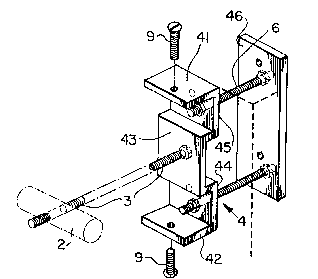Une partie des informations de ce site Web a été fournie par des sources externes. Le gouvernement du Canada n'assume aucune responsabilité concernant la précision, l'actualité ou la fiabilité des informations fournies par les sources externes. Les utilisateurs qui désirent employer cette information devraient consulter directement la source des informations. Le contenu fourni par les sources externes n'est pas assujetti aux exigences sur les langues officielles, la protection des renseignements personnels et l'accessibilité.
L'apparition de différences dans le texte et l'image des Revendications et de l'Abrégé dépend du moment auquel le document est publié. Les textes des Revendications et de l'Abrégé sont affichés :
| (12) Brevet: | (11) CA 2010740 |
|---|---|
| (54) Titre français: | CONNEXION A VERROUILLAGE POUTRE-POTEAU |
| (54) Titre anglais: | POST BEAM LOCK CONNECTION |
| Statut: | Durée expirée - au-delà du délai suivant l'octroi |
| (51) Classification internationale des brevets (CIB): |
|
|---|---|
| (72) Inventeurs : |
|
| (73) Titulaires : |
|
| (71) Demandeurs : | |
| (74) Agent: | MOFFAT & CO. |
| (74) Co-agent: | |
| (45) Délivré: | 1994-05-10 |
| (22) Date de dépôt: | 1990-02-22 |
| (41) Mise à la disponibilité du public: | 1991-08-22 |
| Requête d'examen: | 1990-06-26 |
| Licence disponible: | S.O. |
| Cédé au domaine public: | S.O. |
| (25) Langue des documents déposés: | Anglais |
| Traité de coopération en matière de brevets (PCT): | Non |
|---|
| (30) Données de priorité de la demande: | S.O. |
|---|
A B S T R A C T
A connection for securing a horizontal structural member to
a vertical structural member includes a first plate dimensioned
for attachment to the end of a horizontal member. The first
plate has an inner face apertured to accept a bolt extending
into the horizontal member, and at least one outer face apertured
to accept a bolt extending through the vertical member. The
inner and outer faces are spaced from one another sufficiently
to permit bolt heads to be contained between the members. A
second plate is provided for emplacement on the vertical member
opposite the first plate, second plate being apertured to accept
the bolts extending through the vertical member from the outer
face of first plate. Bolts and bolt securing means connect the
first and second plates together on opposite sides of a vertical
member. A bolt extends into the horizontal member to connect the
first plate thereto.
Note : Les revendications sont présentées dans la langue officielle dans laquelle elles ont été soumises.
Note : Les descriptions sont présentées dans la langue officielle dans laquelle elles ont été soumises.

2024-08-01 : Dans le cadre de la transition vers les Brevets de nouvelle génération (BNG), la base de données sur les brevets canadiens (BDBC) contient désormais un Historique d'événement plus détaillé, qui reproduit le Journal des événements de notre nouvelle solution interne.
Veuillez noter que les événements débutant par « Inactive : » se réfèrent à des événements qui ne sont plus utilisés dans notre nouvelle solution interne.
Pour une meilleure compréhension de l'état de la demande ou brevet qui figure sur cette page, la rubrique Mise en garde , et les descriptions de Brevet , Historique d'événement , Taxes périodiques et Historique des paiements devraient être consultées.
| Description | Date |
|---|---|
| Inactive : Périmé (brevet - nouvelle loi) | 2010-02-22 |
| Inactive : Grandeur de l'entité changée | 2007-02-16 |
| Inactive : CIB de MCD | 2006-03-11 |
| Inactive : Grandeur de l'entité changée | 2002-02-13 |
| Accordé par délivrance | 1994-05-10 |
| Demande publiée (accessible au public) | 1991-08-22 |
| Exigences pour une requête d'examen - jugée conforme | 1990-06-26 |
| Toutes les exigences pour l'examen - jugée conforme | 1990-06-26 |
| Déclaration du statut de petite entité jugée conforme | 1990-02-22 |
Il n'y a pas d'historique d'abandonnement
| Type de taxes | Anniversaire | Échéance | Date payée |
|---|---|---|---|
| TM (brevet, 8e anniv.) - petite | 1998-02-23 | 1998-02-04 | |
| TM (brevet, 9e anniv.) - petite | 1999-02-22 | 1999-02-03 | |
| TM (brevet, 10e anniv.) - petite | 2000-02-22 | 2000-01-21 | |
| TM (brevet, 11e anniv.) - petite | 2001-02-22 | 2001-02-09 | |
| TM (brevet, 12e anniv.) - générale | 2002-02-22 | 2002-02-06 | |
| TM (brevet, 13e anniv.) - générale | 2003-02-24 | 2003-02-19 | |
| TM (brevet, 14e anniv.) - générale | 2004-02-23 | 2004-02-16 | |
| TM (brevet, 15e anniv.) - générale | 2005-02-22 | 2005-02-09 | |
| TM (brevet, 16e anniv.) - générale | 2006-02-22 | 2006-02-16 | |
| TM (brevet, 17e anniv.) - petite | 2007-02-22 | 2007-02-16 | |
| TM (brevet, 18e anniv.) - petite | 2008-02-22 | 2008-02-07 | |
| TM (brevet, 19e anniv.) - petite | 2009-02-23 | 2009-02-18 |
Les titulaires actuels et antérieures au dossier sont affichés en ordre alphabétique.
| Titulaires actuels au dossier |
|---|
| WOLF WILBERT |
| Titulaires antérieures au dossier |
|---|
| S.O. |